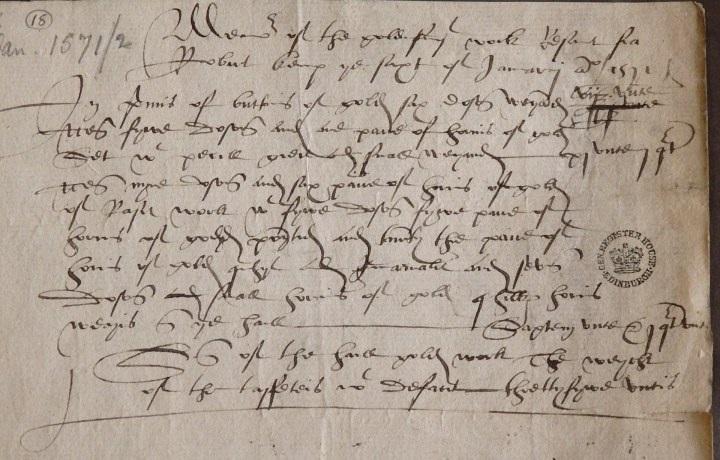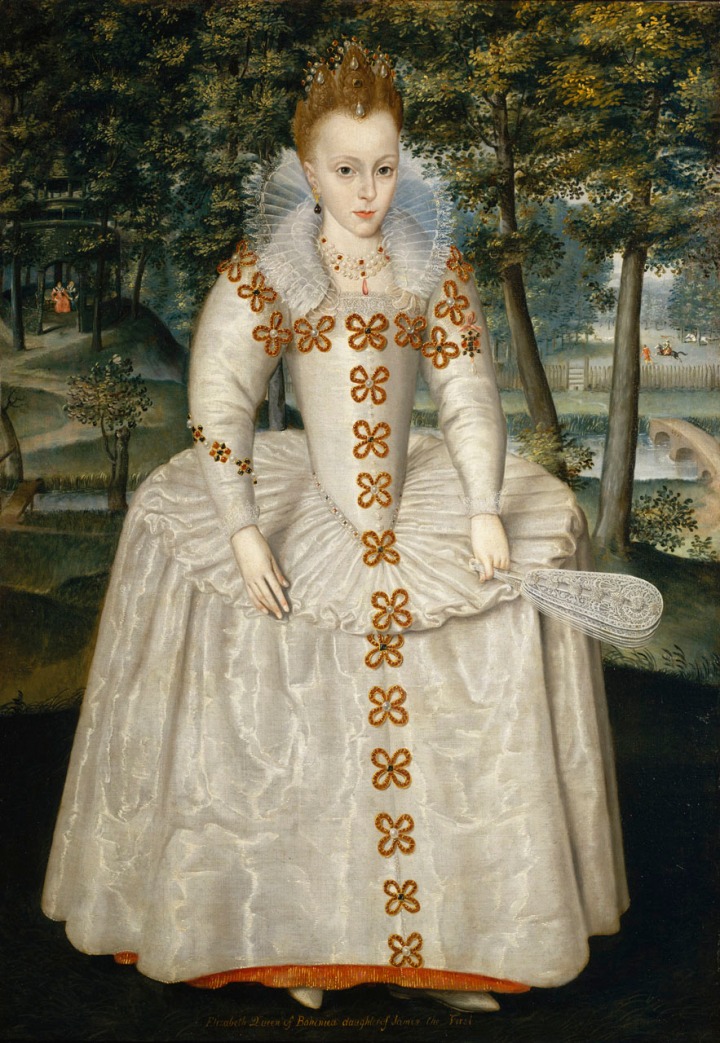Mary, Queen of Scots used buttons and dress fastenings made of gold, which were set with jewels and pearls and enamelled. Some were made in Portuguese style. These are detailed in her inventories (which have been published), and also in receipts written by James Mosman, one of her goldsmiths.
On 6 January 1572, a large quantity of these buttons, horns, points, or aglets were carefully weighed by the goldsmith John Mosman, valued at £2,490 Scots and used as pledges for money loaned to Sir William Kirkcaldy of Grange, who held Edinburgh castle in Mary’s name. These buttons had been stored in a coffer in the castle since Mary’s abdication.
After the castle fell to an English taskforce lead by Sir William Drury, the buttons were (eventually) returned to the victorious Regent Morton who sent them to Annabell Murray, Countess of Mar, at Stirling Castle to sew on the clothes of James VI. Morton also obtained Mosman’s receipts.
The story of the fate of Mary’s personal jewels is told here on wikipedia.
The buttons were described in several documents. The transcripts below from the National Archives of Scotland mention the process of weighing the buttons, deducting or allowing for the ‘deficit’ weight of attached silk or taffeta threading.

In May 1594, Anna of Denmark’s goldsmith Jacob Kroger absconded from Holyroodhouse with his friend Guillaume Martyn, taking a quantity of the queen’s buttons with him. He was arrested near Newcastle and made an inventory of the jewels he had taken, also weighing the buttons and making an allowance for the threading and their red cloth bag. This documentation formed part of a receipt when he and Martyn were handed to Scottish border wardens at Norham. Kroger called the buttons ‘studatis’, and in another list, ‘shells, little and gross, aglets of gold for the setting forth of the body of a gowne’.
Costumes were weighed down by jewelled gold buttons and fixings, and horns or aglets applied as embroidery. Christian Douglas, Countess of Home had a gown made in June 1589, by the Edinburgh tailor Peter Sanderson who would later work for Anna of Denmark. This gown was decorated with 20 gross or 2,680 ‘greit hornis’ at 6s-8d the gross, totalling £6-13s-4d. Buttons for another gown were 40d for a dozen, and fifty great clasps cost two shillings. (reference here) These horns and buttons could not have had much intrinsic value.
Jacob Kroger and his companion Guillaume Martyn were returned to Edinburgh and hanged. James Mosman, the jeweller who weighed Mary’s buttons in 1572 and wrote receipts for lenders, was also hanged, primarily for his role in counterfeiting Scottish money in the castle from the silver brought to the castle in exchange for the pledged buttons.
Francis, Earl of Bothwell
Francis Stewart, 5th Earl of Bothwell, an exile in England, took some of jewels from Jacob Kroger, including a pearl necklace, pearl and garnet bracelets, a diamond brooch, three rings, and pendant featuring a heart made of black stone. He hoped to use them to regain royal favour. This plan was only successful in part. In August 1594 Joachim von Bassewitz, the ambassador of the Duke of Mecklenburg, (Anna of Denmark’s grandfather), was in Scotland for the baptism of Prince Henry. He offered to speak with the English diplomat Robert Bowes on Bothwell’s behalf, but Bowes declined.
A Sequel: Mary, Queen of Scot’s buttons and Elizabeth of Bohemia
When Princess Elizabeth was at York in June 1603, on her way from Scotland, James VI sent her a chain of pearls which she swopped with her mother, Anna of Denmark, for a set of ruby buttons. Years later Elizabeth gave these buttons to her maid of honour Frances Tyrrell. It has been suggested that these ruby buttons are the four-leafed roses of rubies depicted on a portait of Elizabeth at the National Maritime Museum at Greenwich. (See Nadine Akkerman, Correspondence of Elizabeth Queen of Bohemia, vol. 1 (Oxford, 2015), pp. 149-50.)
If so, they correspond with a set of twenty four roses of ruby and roses of diamond buttons or ’boutonieres’ which had belonged to Mary, Queen of Scots, inventoried in Edinburgh Castle in 1578. These were a gift in the 1550s from Henri II of France, (NRS E35/4). Many thanks to the people of twitter for highlighting this button story.

Some documents from the National Archives of Scotland
6 Jan 1572, buttons for the Duke of Châtelherault, NRS E35/11/10.
The dukis obligatioun for 200 crowns of the sun
We James duk of chattellerault erle of arrane lord hamiltoun [-] and lieutenant for the Queen’s majesty. Be the tennour heirof grantis we to have ressavit fra the hands of the rycht honourable Sir Williame Kyrkcaldy of Grange Knycht captain of the castell of Edinburgh. Certane goldsmyth werk, that is; iij dosons buttons of gold inamellit quhite & reid, iij dosons buttons of gold inamellit quhite and blak, quhilks vj dosons of gold as said is weyis in the hail vij unces half ane unce weycht, fyve dosone iiij pair hornis of gold poyntit, nyne dosons pair hornis of gold rasit work, twentie four pair hornis of gold inamellit with quhite, fyve dosons pair hornis gold sett with grete & small perle, & sevin dosons pair small hornis gold, extending in the hail to xxviij dosons iiij pairis hornis of gold quhilks xxviij dosons iiij hornis weyis in the hail the valour of the taffatie be estimatioun resasit of massie weyit to 24 unces extending in the hail the taffatie as said is defasit of massie gold to 31 unce & halff unce wycht. And that in pledge of 200 crouns of the sone ressavit fra us be the said Sir Williame. Quhilk 31 unce half unce weycht of gold as said is we bind and oblissis us faithfullie to render and deliver agane to the said Sir Williame or any uthir in his name, how soon or at what time it shall happen that Sir William to deliver to us the said sum of ij c crowns but ony futher delay fraude or gile. In witness heirof we have subscrivit thir presents with our hand at Edinburgh the sext day of Januar 1571
James Hamilton
6 January 1571/2, buttons from Robert Kemp, NRS E35/11/11.
Memoir of the goldsmyth work resavit fra Robert Kemp the sext of Januarij anno 1571
In primis of buttonis of gold sax doson weyand vij unce fyve drops and ane paire of hornis of gold set with pearl greit and small weyand __ xj unce j quarters
Item nyne dosoun and sax pair of hornis of gold of rasit work with fyve doson fyve pair of hornis of gold poyntis and fourty three paire of horns of gold quhyt and anamellit and sevin doson small hornis of gold which hornis weight in the whole __ 16 ounces & j quarters
Sum of the haill gold work the weycht of the taffeteis with defacit __ 35 ounces.
6 Jan 1572, buttons taken from the jewel coffer, NRS E35/11/13.
ij M iiij C iiijXX x li xiiij s [ £2,490-14s – the total value of buttons ]
Of buttons of the fashion of Portingaill – ane pound aucht unce and a half
Of buttons with rubies – two pounds six ounces.
Of great buttons of bullion enamelled white and great buttons of turquoise and little buttons enamelled black and white __ fifteen ounces
Of garnisons _______ tua pound fyve ounces.
Of horns __________ ane pound aucht ounce
Sum aucht pounds ten unces and a half unce.
This above written wes tane out of the coffer the vj of Januar 1572 and laid in wed to the persons contenit in the other writings.

Anna of Denmark’s buttons
26 May 1594, Anna of Denmark’s buttons at Tynemouth, TNA SP15/33/32.
… Shills, litle and groas aglets of gould for the setting forth of the body of a gowne __ 600 crownes.
11 June 1594, Anna of Denmark’s buttons at Norham, TNA SP15/33/48.
… the parcells of gudis following, In goldin studatis aglettis within ane litle bag of reid bukram and ane string of quhite taipe the bag and all weying togidder with the sylke threidings amangs the said studeits quhilks altogidder do way xxxviij [?] unces of goldsmyth wecht and lx pennies wecht mair.